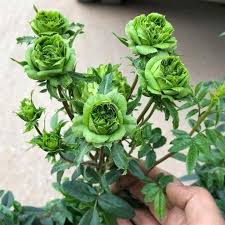Hydroponic cultivation offers an innovative approach to growing plants, providing optimal conditions for nutrient uptake and growth without the need for soil. In this section, we delve into the world of hydroponic cultivation techniques for Rosa gallica, exploring the methods, benefits, and considerations involved in growing this beloved flower hydroponically.

Understanding Hydroponics: A Soil-Free Growing Method
- Hydroponic Principles: Hydroponics is a method of growing plants in a nutrient-rich water solution, with the plant’s roots suspended in or exposed to the solution. This soilless growing technique allows for precise control over nutrient levels, pH balance, and environmental conditions, promoting healthy plant growth and maximizing yields.
- Advantages of Hydroponics: Hydroponic cultivation offers several advantages over traditional soil-based growing methods. These include faster growth rates, higher yields, reduced water usage, and the ability to grow plants in limited space or urban environments. Additionally, hydroponic systems are less susceptible to soil-borne pests and diseases, minimizing the need for pesticides and chemical fertilizers.
- Types of Hydroponic Systems: There are various types of hydroponic systems suited for growing Rosa gallica, each with its own advantages and applications. These include:
- Nutrient Film Technique (NFT): In NFT systems, a shallow stream of nutrient solution continuously flows over the plant roots, providing a constant supply of water and nutrients.
- Deep Water Culture (DWC): DWC systems involve suspending plant roots in a nutrient solution reservoir, with an air pump providing oxygen to the roots.
- Ebb and Flow (Flood and Drain): Ebb and flow systems periodically flood the growing medium with nutrient solution before draining it away, allowing for oxygenation of the roots between cycles.
- Aeroponics: Aeroponic systems mist the plant roots with a nutrient solution, suspending them in the air, which promotes rapid nutrient absorption and oxygenation.
Hydroponic Cultivation of Rosa Gallica: Techniques and Considerations
- Selection of Cultivars: When choosing Rosa gallica cultivars for hydroponic cultivation, it’s essential to select varieties that are well-suited to controlled growing conditions. Look for cultivars that are known for their vigor, disease resistance, and suitability for greenhouse cultivation.
- Growing Medium: While hydroponic systems eliminate the need for soil, a growing medium is still necessary to support the plant roots and provide stability. Common hydroponic growing mediums include perlite, vermiculite, coconut coir, rockwool, and expanded clay pellets. Choose a growing medium that provides good drainage, aeration, and water retention properties.
- Nutrient Solution: A properly balanced nutrient solution is crucial for the healthy growth of Rosa gallica in hydroponic systems. Commercial hydroponic nutrient formulations are available, or you can mix your own using water-soluble fertilizers. The nutrient solution should contain essential macronutrients (nitrogen, phosphorus, potassium) and micronutrients (calcium, magnesium, iron) in appropriate concentrations for optimal plant growth.
- pH and EC Monitoring: Maintaining the correct pH and electrical conductivity (EC) levels of the nutrient solution is essential for nutrient uptake and plant health. The ideal pH range for Rosa gallica hydroponic cultivation is typically between 5.5 and 6.5, while the EC level should be monitored to ensure that the nutrient concentration is within the desired range for the growth stage of the plant.
- Lighting Requirements: Providing adequate lighting is essential for the photosynthetic process and overall growth of Rosa gallica in hydroponic systems. LED grow lights are commonly used in hydroponic setups due to their energy efficiency and customizable spectrum options. Ensure that the lighting intensity and duration are optimized for the plant’s growth stage to promote healthy foliage and flower development.
- Temperature and Humidity Control: Maintaining optimal environmental conditions, including temperature and humidity levels, is crucial for Rosa gallica hydroponic cultivation. Aim for daytime temperatures between 18-24°C (65-75°F) and nighttime temperatures around 15-18°C (59-65°F), with relative humidity levels around 50-70% to prevent stress and disease development.
- Pollination: In hydroponic systems, manual pollination may be necessary to ensure successful fruit set and seed production in Rosa gallica. Use a small brush or cotton swab to transfer pollen from one flower to another, mimicking the action of pollinating insects.
Conclusion: Embracing Innovation in Rosa Gallica Cultivation
Hydroponic cultivation offers an exciting opportunity to grow Rosa gallica with precision, efficiency, and sustainability. By harnessing the power of hydroponic systems, growers can optimize nutrient delivery, environmental control, and resource utilization to maximize the growth and quality of Rosa gallica plants. Whether for commercial production or personal enjoyment, hydroponic cultivation opens new avenues for exploring the beauty and versatility of this beloved flower. Join the growing community of hydroponic enthusiasts and embark on a journey of innovation and discovery in Rosa gallica cultivation.
Advancing Hydroponic Techniques for Rosa Gallica Cultivation
As we delve further into the realm of hydroponic techniques for cultivating Rosa gallica, we explore advanced methods, cutting-edge technologies, and practical tips for maximizing the growth and productivity of this cherished flower.
Cutting-Edge Hydroponic Systems: Pushing the Boundaries of Innovation
- Vertical Hydroponics: Vertical hydroponic systems utilize vertical space to maximize growing area while minimizing footprint. By stacking multiple growing layers vertically, growers can increase plant density and optimize light exposure, resulting in higher yields per square meter. Vertical hydroponic systems are ideal for urban farming, commercial greenhouse production, and indoor cultivation facilities.
- Aquaponics Integration: Aquaponics combines hydroponics with aquaculture, creating a symbiotic ecosystem where plants and fish mutually benefit from each other’s waste products. In aquaponic systems, fish waste provides nutrients for plant growth, while plants help filter and purify the water for fish. By integrating Rosa gallica into aquaponic setups, growers can harness the natural synergy between plants and fish to create a self-sustaining and environmentally-friendly cultivation system.
- Hydroponic Drip Systems: Drip irrigation systems deliver nutrient solution directly to the plant roots through a network of drip lines and emitters, ensuring precise and efficient nutrient delivery. Hydroponic drip systems can be customized to deliver specific nutrient formulations and water volumes based on the needs of Rosa gallica at different growth stages. This level of control allows growers to optimize plant health and productivity while conserving water and resources.
- Automated Nutrient Monitoring: Advanced hydroponic systems incorporate sensors, probes, and automated control systems to monitor and adjust nutrient levels in real-time. These systems measure parameters such as pH, EC, dissolved oxygen, and nutrient concentrations, allowing growers to maintain optimal growing conditions with minimal manual intervention. Automated nutrient monitoring ensures precise nutrient delivery, prevents nutrient imbalances, and maximizes plant health and yield.
Optimal Growing Conditions: Fine-Tuning Environmental Parameters for Rosa Gallica
- Temperature Regulation: Maintaining optimal temperature levels is crucial for Rosa gallica hydroponic cultivation, as temperature influences plant metabolism, growth rates, and flowering patterns. Temperature-controlled environments, such as climate-controlled greenhouses or indoor grow rooms, allow growers to fine-tune temperature settings to match the plant’s physiological needs throughout the growth cycle.
- Humidity Management: Proper humidity levels are essential for preventing stress, disease, and physiological disorders in Rosa gallica plants. High humidity can lead to fungal diseases and waterlogged roots, while low humidity can cause wilting and dehydration. Growers use humidifiers, dehumidifiers, and ventilation systems to regulate humidity levels and maintain an optimal growing environment for Rosa gallica.
- CO2 Enrichment: Carbon dioxide (CO2) enrichment can enhance photosynthesis rates and overall plant growth in hydroponic systems. By supplementing ambient CO2 levels with controlled CO2 injection or enrichment methods, growers can boost Rosa gallica’s growth rates and improve flower production. CO2 enrichment is particularly beneficial in enclosed or indoor growing environments with limited CO2 exchange with the atmosphere.
- Light Spectrum Optimization: LED grow lights offer customizable light spectra that can be tailored to match Rosa gallica’s specific light requirements at different growth stages. By adjusting light intensity, duration, and spectrum, growers can optimize photosynthesis, flower development, and plant morphology. Full-spectrum LED grow lights mimic natural sunlight and provide the ideal light conditions for Rosa gallica cultivation in indoor or greenhouse settings.
Nutrient Formulation and Management: Fine-Tuning Nutrient Solutions for Optimal Growth
- Macro and Micronutrient Balance: Rosa gallica requires a balanced supply of macronutrients (nitrogen, phosphorus, potassium) and micronutrients (calcium, magnesium, iron) for healthy growth and flowering. Hydroponic nutrient formulations should be carefully calibrated to provide the correct ratios of nutrients throughout the plant’s growth cycle. Periodic nutrient solution analysis and adjustment ensure that Rosa gallica receives all essential nutrients in the right proportions.
- pH and EC Monitoring: pH and electrical conductivity (EC) levels of the nutrient solution should be monitored regularly to maintain optimal nutrient uptake and pH balance. Rosa gallica prefers slightly acidic growing conditions, with a pH range of 5.5-6.5. Fluctuations in pH can affect nutrient availability and plant health, so growers use pH meters and EC meters to monitor and adjust nutrient solution parameters as needed.
- Supplemental Nutrient Boosters: In addition to standard hydroponic nutrient formulations, growers may use supplemental nutrient boosters or additives to enhance Rosa gallica’s growth and flowering. These may include organic additives, bio-stimulants, and plant growth regulators that promote root development, flowering, and stress resistance. Careful attention to nutrient management and supplementation can optimize Rosa gallica’s performance in hydroponic systems.
Conclusion: Embracing Innovation in Hydroponic Rosa Gallica Cultivation
As hydroponic technology continues to evolve and innovate, growers have unprecedented opportunities to maximize the growth, productivity, and quality of Rosa gallica in controlled growing environments. By harnessing cutting-edge hydroponic systems, fine-tuning environmental parameters, and optimizing nutrient management practices, growers can unlock the full potential of this beloved flower and cultivate Rosa gallica with precision, efficiency, and sustainability. Join the forefront of hydroponic innovation and embark on a journey of discovery and growth in Rosa gallica cultivation.









